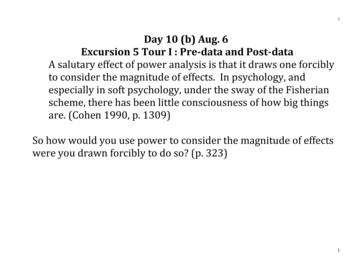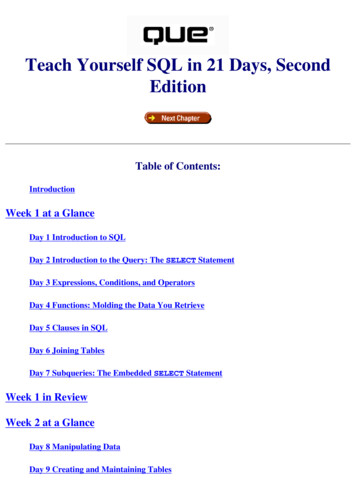
Transcription
1Day 10 (b) Aug. 6Excursion 5 Tour I : Pre-data and Post-dataA salutary effect of power analysis is that it draws one forciblyto consider the magnitude of effects. In psychology, andespecially in soft psychology, under the sway of the Fisherianscheme, there has been little consciousness of how big thingsare. (Cohen 1990, p. 1309)So how would you use power to consider the magnitude of effectswere you drawn forcibly to do so? (p. 323)1
2Power is one of the most abused notions in all of statisticsPower is always defined in terms of a fixed cut-off cα, computedunder a value of the parameter under testThese vary, there is really a power function.If someone speaks of the power of a test tout court, you cannotmake sense of it, without qualification.The power of a test against μ’, is the probability it would lead torejecting H0 when μ μ’. (3.1)POW(T, μ’) Pr(d(X) cα; μ μ’), or Pr(Test T rejects H0; μ μ’).2
3Power measures the capability of a test to detect μ’–where thedetection is in the form of producing a d cα.Power is computed at a point μ μ’, we use it to appraise claims ofform μ μ’ or μ μ’.Power is an ingredient in N-P tests, but even Fisherians invokepowerYou won’t find it in the ASA P-value statement.3
4Two errors in Jacob Cohen’s definition in his (1969/1988)Statistical Power Analysis for the Behavioral Sciences (SIST p. 324)Keeping to the fixed cut-off cα is too coarse for the severe testerWe will see why in doing power analysis today.The data-dependent version was in (3.3), but now we’ll focus on it.Power: POW(T, μ’) Pr(d(X) cα; μ μ’)Achieved sensitivity” or “attained power”Π(γ) Pr(d(X) d(x0); μ’)μ’ µ0 γ4
5N-P accorded three roles to power: first two are pre-data, forplanning, comparing tests; the third for interpretation post-data.(I broke Tours I and II at the last minute)Oscar Kempthorne (being interviewed by J. Leroy Folks (1995))said (SIST 325):“Well, a common thing said about [Fisher] was that he did notaccept the idea of the power. But, of course, he must have.However, because Neyman had made such a point abut power,Fisher couldn’t bring himself to acknowledge it” (p. 331).It’s too performance oriented, Fisher claimed 1955.5
65.1 Power Howlers, Trade-offs and BenchmarksIn the Mountains out of Molehills (MM) Fallacy (4.3), an α-levelrejection with a larger sample size (higher power) is taken asevidence of a greater discrepancy from the null hypothesis thanwith a smaller sample size (in tests otherwise the same).Power can also be increased by computing it in relation toalternatives further and further from the null.Mountains out of Molehills (MM) Fallacy (second form) Test T :The fallacy of taking a just significant difference at level α (i.e.,d(x0) dα) as a better indication of a discrepancy μ’ if thePOW(μ’) is high than if POW(μ’) is low.6
7(SIST 326)Example. A test is practically guaranteed to reject H0, the “noimprovement” null, if in fact H1 the drug cures practicallyeveryone.It has high power to detect H1. But you wouldn’t say that itsrejecting H0 is evidence H1 cures everyone.To think otherwise is statistical affirming the consequent–thebasis for the MM fallacy.Stephen Senn. In drug development, it is typical to set a highpower of .8 or .9 to detect effects deemed of clinical relevance. TestT : Reject H0 iff Z zα (Z is the standard Normal variate).A simpler presentation to use the cut-off for rejection in terms of𝑥̅ α: Reject H0 iff ̅X 𝑥̅ α (μ0 zασ n).7
8Abbreviate: the alternative against which test T has .8 power byμ.8 .So POW(μ.8) .8.Suppose μ.8 is the clinically relevant difference.Can we say, upon rejecting the null hypothesis, that there’sevidence the treatment has a clinically relevant effect, i.e., μ μ.8?(bott SIST, 328) “This is a surprisingly widespread piece ofnonsense which has even made its way into one book on drugindustry trials” (ibid., p. 201).μ.8 the cut-off for rejection, in particular, μ.8 𝑥̅𝛼 .85 𝜎𝑋̅(where 𝜎𝑋̅ σ/ n).8
9An easy alternative to remember: (SIST 329): μ.84 :The power of test T to detect an alternative that exceeds the cutoff 𝑥̅𝛼 by 1𝜎𝑋̅ .84.The result of adding 1𝜎𝑋̅ to 𝑥̅𝛼 : That takes us to a value of μ againstwhich the test has .84 power: μ.84 :9
10Trade-offs and Benchmarks̅𝜶 the power goes from α to .5.Between H0 and 𝒙a. The power against H0 is α. We can use the power function todefine the probability of a Type I error or the significance level ofthe test:POW(T , μ0 ) Pr(𝑋̅ 𝑥̅𝛼 ; μ0), 𝑥̅𝛼 (μ0 zα𝜎𝑋̅ ), 𝜎𝑋̅ [σ/ n])The power at the null is: Pr(Z zα;μ0) α.It’s the low power against H0 that warrants taking a rejection asevidence that μ μ0 .We infer an indication of discrepancy from H0 because a null worldwould probably have yielded a smaller difference than observed.10
11Example 1: Left Side: Sample size: 100; Observed mean difference(from null): 2; Alpha: 0.025Right side: “discrepancy value” is 0. Power is .025 (same as alpha)11
12b. The power of T for μ1 𝑥̅𝛼 is .5. Here, Z 0, and Pr(Z 0) .5, so:POW(T , μ1 𝑥̅𝛼 ) .5.discrepancy 2,power is 0.512
13The power .5 only for alternatives that exceed the cut-off 𝑥̅𝛼 ,We get the shortcuts on SIST p. 328Remember 𝑥̅𝛼 is (μ0 zα𝜎𝑋̅ ).marcosjnez.shinyapps.io/Severity/13
14Trade-offs Between α, the Type I Error Probability and PowerWe know for a given test, as the probability of a Type I error goesdown the probability of a Type II error goes up (and power goesdown).If someone said: As the power increases, the probability of a Type Ierror decreases, they’d be saying, as the Type II error decreases,the probability of a Type I error decreases.That’s the opposite of a trade-off!Many current reforms do just this! After this seminar, you canreadily be on the look-out, and refuse to be fooled.14
15In test T the range of possible values of 𝑋̅ and µ are the same, sowe are able to set µ values this way, without confusing theparameter and sample spaces.Exhibit (i). In SIST I let n 25 in Test T (α .025)H0: μ 0 vs. H1: μ 0, α .025, n 25, σ 1.But let’s keep to n 100Say you must decrease the Type I error probability α to .001 butit’s impossible to get more samples.This requires the hurdle for rejection to be higher than in ouroriginal test.The new cut-off, for test T (α .001), will be 𝑥̅.001.15
16Old cut off was 2, new cut-off is 3, it must be 3𝜎𝑋̅ greater than 0rather than only 2𝜎𝑋̅ :μ.5 𝑥̅𝛼 ,With α .05, the smallest alternative the test has 50% power todetect is μ.5 2With α .001, the smallest alternative the test has 50% power todetect is μ.5 3Decreasing the Type I error by moving the hurdle over to the rightby 1𝜎𝑋̅ unit results in the alternative against which we have .5power µ.5 also moving over to the right by 1𝜎𝑋̅ .We see the trade-off very neatly, at least in one direction.16
17Ziliak and McCloskey get their hurdles in a twist SIST p. 330-1,Their slippery slides are quite illuminating.If the power of a test is low, say, .33, then the scientist will twotimes in three accept the null and mistakenly conclude thatanother hypothesis is false. If on the other hand the power of atest is high, say, .85 or higher, then the scientist can bereasonably confident that at minimum the null hypothesis (of,again, zero effect if that is the null chosen) is false and thattherefore his rejection of it is highly probably correct (Ziliakand McCloskey 2013, p. 132-3).If the power of a test is high, then a rejection of the null is probablycorrect?17
18We follow our rule of generous interpretation (SIST 331)We may coin:The high power high hurdle (for rejection) fallacy.A powerful test does give the null hypothesis a harder time in thesense that it’s more probable that discrepancies are detected.That makes it easier for H1.18
19Negative results: d(x0) cα:(SIST 339)A classic fallacy is to construe no evidence against H0 as evidenceof the correctness of H0.A canonical example was in the list of slogans opening this book:Power analysis uses the same reasoning as significance tests.Cohen:[F]or a given hypothesis test, one defines a numerical value i(or iota) for the [population] ES, where i is so small that it isappropriate in the context to consider it negligible (trivial,inconsequential). Power (1 –β) is then set at a high value, sothat β is relatively small. When, additionally, α is specified, ncan be found.19
20Now, if the research is performed with this n and it results innonsignificance, it is proper to conclude that the population ESis no more than i, i.e., that it is negligible (Cohen 1988, p. 16;α, β substituted for his a, b).Ordinary Power Analysis: If data x are not statisticallysignificantly different from H0, and the power to detectdiscrepancy γ is high, then x indicates that the actualdiscrepancy is no greater than γ20
21Neyman Chides Carnap, Again (SIST 341)In his “The Problem of Inductive Inference” (1955) where hechides Carnap for ignoring the statistical model (2.7).“I am concerned with the term ‘degree of confirmation’ introduced byCarnap. We have seen that the application of the locally best one-sidedtest to the data failed to reject the hypothesis [that the 26 observationscome from a source in which the null hypothesis is true]. The question is:does this result ‘confirm’ the hypothesis that H0 is true of the particulardata set]? ”.Ironically, Neyman (1957a,b) also criticizes Fisher’s move from alarge P-value to inferring the null hypothesis asmuch too automatic [because] .large values of P may beobtained when the hypothesis tested is false to an importantdegree. Thus, it is advisable to investigate what is the21
22probability (of error of the second kind) of obtaining a largevalue of P in cases when the [null is false. to a specifieddegree]. (1957a, p. 13)Should this calculation show that the probability of detectingan appreciable error in the hypothesis tested was large, say .95or greater, then and only then is the decision in favour of thehypothesis tested justifiable in the same sense as the decisionagainst this hypothesis is justifiable when an appropriate testrejects it at a chosen level of significance. (1957b, pp.16-17)22
23“Locally best one-sided Test TA sample X (X1, ,Xn) each Xi is Normal, N( , 2), (NIID), assumed known; M the sample meanH0: 0 against H1: 0.Test Statistic d(X) (M - 0)/ x, x / 𝑛Test fails to reject the null, d(x0) c .“The question is: does this result ‘confirm’ the hypothesis that H0 is trueof the particular data set]? ” (Neyman).Carnap says yes 23
24Neyman:“ .the attitude described is dangerous. the chance of detecting the presence [of discrepancy γ from thenull], when only [this number] of observations are available, isextremely slim, even if [γ is present].“One may be confident in the absence of that discrepancy only if thepower to detect it were high”. (power analysis)If Pr(d(X) c ; 0 γ) is highd(X) c ;infer: discrepancy γ24
25Probem: Too CoarseConsider test T (α .025): H0: μ 0 vs. H1: μ 0, α .025, n 100,σ 10, 𝜎𝑋̅ 1. Say the cut-off must be 𝑥̅.025 2.Consider an arbitrary inference μ 1.We know POW(T , μ 1) .16 (1𝜎𝑋̅ is subtracted from 2).16 is quite lousy power.It follows that no statistically insignificant result can warrant μ 1for the power analyst.Suppose, 𝑥̅0 -1. This is 2𝜎𝑋̅ lower than 1. That should be takeninto account.25
26We do. SEV(T , 𝑥̅0 -1, μ 1) .975.Z (-1 -1)/1 -2SEV (μ 1) Pr (Z z0; μ 1) .975It would be even larger for values of μ smaller than 126
27(1) P(d(X) c ; 0 γ) Power to detect γ Just missing the cut-off c is the worst case It is more informative to look at the probability of getting a worse fitthan you did(2) P(d(X) d(x0); 0 γ) “attained power”a measure of the severity (or degree of corroboration) for the inference 0 γNot the same as something called “retrospective power” or “ad hoc”power! (There is identified with the observed mean– later)27
28Mayo and Spanos (2006, p. 337):Test T: Normal testing: H0: 0 vs H1: 0 is known(SEV): If d(x) is not statistically significant, then test T passes µ M0 k n.5 with severity ( 1 – ),where P(d(X) k ) .The connection with the upper confidence limit is obvious.28
291.1. If one wants a post-data measure, one can write:SEV( M0 γ x) to abbreviate:The severity with which( M 0 γ x).passes test TIt’s computed Pr(d(X) d(x0); 0 γ)Severity has 3 terms: SEV(Test, outcome, inference)29
30One can consider a series of upper discrepancy bounds SEV( M 0 0 x) .5SEV( M 0 .5 x) .7SEV( M 0 1 x) .84SEV( M 0 1.5 x) .93SEV( M 0 1.96 x) .975This seems to relate to work by Min-ge Xie and others on confidencedistributions.But aren’t I just using this as another way to say how probable eachclaim is?30
31No. This would lead to inconsistenciesProbability gives the wrong logic for “how well-tested”(or “corroborated”) a claim is(there may be a confusion of ordinary language use of “probability”:belief is very different from well-testedness)Note: low severity is not just a little bit of evidence, but bad evidence,no test (BENT)31
32The severity construal is different from what I call theRubbing off construal: The procedure is rarely wrong, therefore, theprobability it is wrong in this case is low.Still too much of a performance criteria, too behavioristicThe long-run reliability of the rule is a necessary but not asufficient condition to infer H (with severity)32
33The reasoning instead is counterfactual:H: M0 1.96 x(i.e., CIu )H passes severely because were this inference false, and the true mean CIu then, very probably, we would have observed a larger samplemean:33
34What enables substituting the observed value of the teststatistic, d(x0), is the counterfactual reasoning of severity:If, with high probability, the test would have resulted in alarger observed difference (a smaller P-value) than it did, if thediscrepancy was as large as γ, then there’s a good indicationthe discrepancy is no greater than γ, i.e., that μ μ0 γ.That is, if the attained power of T against μ μ0 γ (i.e., Π(γ))is very high, the inference to μ μ0 γ is warranted with severity.34
35Power Analysis: If Pr(d(X) cα; µ’) high and the result is notsignificant, then it’s an indication or evidence that µ µ’.Severity Analysis: If Pr(d(X) d(x0); µ’) high and the result isnot significant, then it’s an indication or evidence that µ µ.’If Π(γ) is high it’s an indication or evidence that µ µ.’35
Aug 08, 2019 · N-P accorded three roles to power: first two are pre-data, for planning, comparing tests; the third for interpretation post-data. (I broke Tours I and II at the last minute) Oscar Kempthorne (being interviewed by J. Leroy Folks (1995)) said (SIST 325): “Well, a common thing said about [Fisher] was that

![Welcome [dashdiet.me]](/img/17/30-day-weight-loss-journal.jpg)









